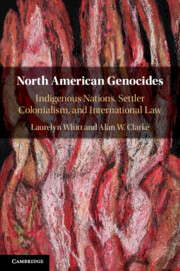Book contents
- North American Genocides
- North American Genocides
- Copyright page
- Dedication
- Epigraph
- Contents
- Preface
- Acknowledgments
- Introduction
- Chapter 1 North American Genocide Denial
- Chapter 2 The Legal Case for North American Genocides: a Retrospective Methodology
- Chapter 3 Settler Colonialism and Indigenous Nations
- Chapter 4 A Legal Primer for Settler Colonial Genocides
- Chapter 5 The Beothuk Nation (1500–1830)
- Chapter 6 The Powhatan Tsenacommacah (1607–1677)
- Chapter 7 The Conventional Account of Genocide: from a Restrictive to an Expansive Interpretation
- Chapter 8 Toward an Account of Systemic Genocide
- Appendix Convention on the Prevention and Punishment of the Crime of Genocide
- Index
Chapter 6 - The Powhatan Tsenacommacah (1607–1677)
Published online by Cambridge University Press: 12 July 2019
- North American Genocides
- North American Genocides
- Copyright page
- Dedication
- Epigraph
- Contents
- Preface
- Acknowledgments
- Introduction
- Chapter 1 North American Genocide Denial
- Chapter 2 The Legal Case for North American Genocides: a Retrospective Methodology
- Chapter 3 Settler Colonialism and Indigenous Nations
- Chapter 4 A Legal Primer for Settler Colonial Genocides
- Chapter 5 The Beothuk Nation (1500–1830)
- Chapter 6 The Powhatan Tsenacommacah (1607–1677)
- Chapter 7 The Conventional Account of Genocide: from a Restrictive to an Expansive Interpretation
- Chapter 8 Toward an Account of Systemic Genocide
- Appendix Convention on the Prevention and Punishment of the Crime of Genocide
- Index
Summary
James I granted the Virginia Company of London its first Royal Charter (of April 1606) for a colony south of the Potomac. It operated with the consent of Parliament, under both royal and private control, although the King (under this initial Charter) “possessed ultimate supervisory control.” He appointed the members of the King’s Council of Virginia who directed the corporation’sand who were in turn charged with nominating each colony’s governing council. James I declared that he intended, in creating this entity, to convert and civilize the Indigenous inhabitants of North America. Several months later, he enjoined prospective settlers to “use all good meanes to draw the salvages and heathen people … to the true service and knowledge of God” and to use “all just, kind and charitable courses” in encouraging Indians to “conforme themselves to … sociable traffique whereby they may the sooner be drawne to the true knowledge of God and the obedience of us.” The Virginia Company was, nevertheless, also a profit-oriented enterprise – a joint-stock company which sold shares and was organized to bring profit to its shareholders. It has been described as “an instrument for the accomplishment of national purposes” and a “national corporation for Christian imperialism and mercantile benefits.” As one historian observes, “Mammon and God could be served simultaneously without qualms of incompatibility” during the seventeenth century. Indeed, service to God was thought to be rewarded by gifts from Mammon. Samuel Purchase, whose extensive contributions to popular travel stories of the time spurred colonization, wrote: “All the rich endowments of Virginia are wages for all this worke: God in wisedome having enriched the Savage Countries, that those riches might be attractives for Christian suters, which there may sowe spirituals and reape temporals.”
- Type
- Chapter
- Information
- North American GenocidesIndigenous Nations, Settler Colonialism, and International Law, pp. 117 - 161Publisher: Cambridge University PressPrint publication year: 2019

